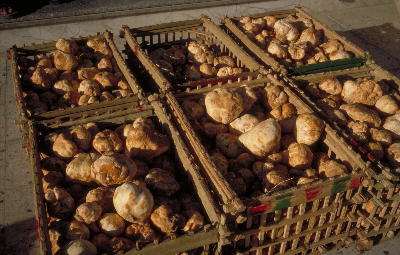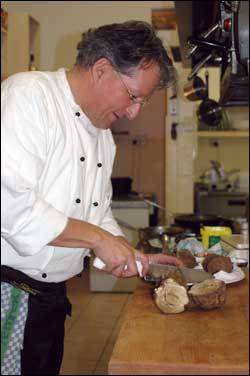Two weeks ago I was over visiting my good friends in the bush kitchen at Jacks Camp in the Kalahari desert. One morning ritual during March is to head out early with Cobra the bushman in search of Terfezia Pfeilii, or the wonderful Kalahari Truffle! This year has graced us with a wonderful wet season and the usual red dusty sand was rich and green with straw grass. During our morning hunt we came across the Nama tribe (local bushmen from Namibia) who were sharing their excitement with us as they had revealed a bumper crop of more than twenty pounds of truffle in only a few hours!

These wild truffles are quite different from the French tubers we prepare, resembling a dark rather nobbled nugget of fresh ginger. In Botswana we celebrate them in dishes just as we would the humble potato--sliced and fried in butter or olive oil, pureed, grilled, baked or even boiled. One secret I have learned from the local ladies here is to bake these little wonders slowly in hot coals at night and let them cool--this intensifies their delicious earthy flavour, and the following day they are sliced cold and eaten with grilled meats!

They are closely related to the desert truffle of North Africa, which can also be found in the Middle East. In our Luxuary Safari Camp bush kitchens we have adapted some new and exciting recipes and added this unique local flavour to our menus. I have had much success grating them and adding them to rosti potatoes for breakfast; once roasted they are a subtle complement to a healthy salad of peppery rocket and grilled fresh snapper and pecorino macadamia pesto. These Kalahari truffles are always served in generous portions, sliced thick and often grilled with some olive oil and seasoning--unlike the fine shavings we ration over delicate fresh pasta dishes with our Italian white Alba cousin or our French black perigord truffle found in the Southeast of France, from where 70% of the world's truffle is exported (an annual collection of over 50 tonnes). The Kalahari tuber is less pungent in its aroma and is not as suited to preserving in oils as are European truffles. In Italy and France a special breed of pig is used to sniff out the delicate tuber from under the root of forest trees, but in Africa it is the bushmen and family with years of experience who yield these precious gems themselves, and it is this little hidden treasure that we find sometimes only once every four years that we cherish.

On our trip back to camp with our collection of almost five pounds of truffle (not bad for four hours' work) we were stopped by Cobra who pointed out a tiny cactus like shoot in a dry part of the sandy ground. He got to his knees and started digging with his hands. To my astonishment after about 5 minutes digging he began to pull from the hole a huge bulb the size of a football--he shook it next to his ear and then called me. "We have luck!" he proclaimed. He then found a small rock (very rare in the desert) and gently cracked the tuber against the rock--it was full of a milky water which he began to drink generously. He passed me the bulb and I shared his find. This, he explained, is how we the bushmen survive spending long days hunting in the Kalahari, and this refreshing water did more than just quench one's thirst--it also has special medicinal purposes and protected against liver disease! With that we began to head back, and I felt confident that I was in safe hands and would survive to tell my story around the dinner table of our search and successful find of the Kalahari truffle!